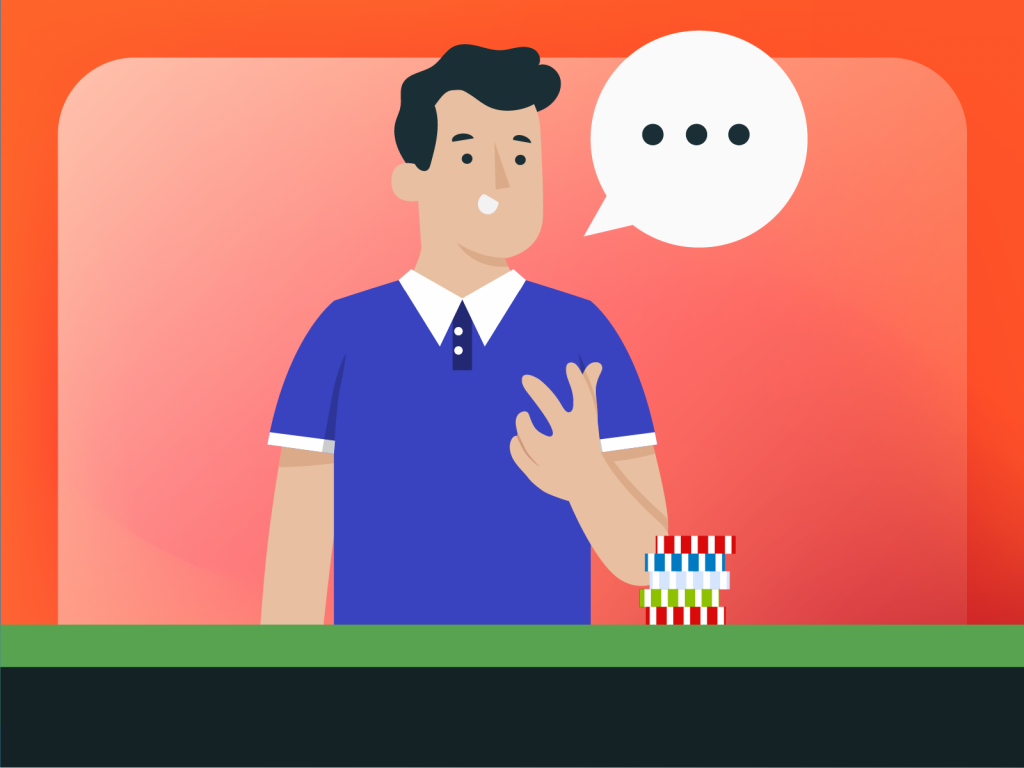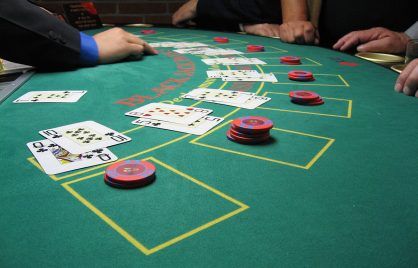How To Read Your Opponents When Playing Poker

Poker tells can give you a lot of valuable insights, but they shouldn’t be the only thing you consider when making decisions.
If you want to be good at reading your opponents when playing poker, you need to make use of all the information available.
Everything from bet sizing, behavior, and even the time they take to make a decision, can be important in figuring out your opponent’s holdings.
Let’s take a look at the most effective ways to read your opponents in poker.
The Most Important Part: Putting Your Opponents On A Range
No matter if you’re playing live or online poker, the most important part of reading your opponents is putting them on a range.
The ‘range’ is the various possible hands they could hold, so putting them on a range means trying to figure out what those hands could be.
As the hand plays out and your opponent makes more decisions and takes more actions, you can use this information to narrow down their range.
It’s a vital skill to master.
But instead of thinking about ranges, many players try to guess the exact hand of their opponents on the river. This approach doesn’t work.
Good players don’t make blind guesses; they use a methodical approach.
Even though it requires a lot of practice, you can learn to put your opponent on a range by following these four simple steps.
Step 1: Analyze preflop actions
If you want to put your opponent on an accurate range of cards by the river, you should start your work preflop.
The first thing you need to consider is your opponent’s position.
They will be playing completely different hands from under the gun (UTG) and button (BTN), so it’s vital to assign them a realistic range.
A player who is raising from the first position will not have 63s in their range, so is very unlikely to have strong holdings on the flop with 633.
However, a player on the BTN can easily have such hands, and way more other 3x holdings, so you need to play differently against these ranges.
Knowing the position is not enough. You also have to identify your opponent’s type.
If they’re passive, they could be playing just 15% of hands from the cutoff (CO), while an aggressive opponent could be opening 35% or even more.
The same thought process should be applied for other situations when someone limps, or you face a 3-bet.
When you evaluate your opponent’s position and playing style, you can already make an educated guess of what hands they could be playing.
Step 2: Narrow down the range based on flop action
The next step is quite straightforward. Using information from the flop action, you can narrow down their range.
You can learn what your opponent should do in any given situation by studying game theory optimal (GTO) strategy and then adjust these ranges based on your observations.
This will help you understand what hands your opponent should be checking or betting and then reduce their likely holdings accordingly.
Step 3: Evaluate additional information
To narrow down the range even further, you should look at all the other information available to you.
Things like your opponent’s poker stats, bet sizing, or even physical tells can say a lot about their holdings. The table dynamics will give you a ton of additional insights.
This is a huge part of poker, so we’ll come back to it later on in the article.
Step 4: Keep reducing their possible holdings on the turn and river
Just like you did in the second step for the flop play, you can continue reducing your opponent’s possible holdings based on their actions and community cards on the turn and river.
It’s worth saying that lots of people have a similar playing style and share similarities that are easy to notice and exploit.
An example would be that they don’t adjust to the situation. If you notice someone checking top pair with a weak kicker on the flop, they’re very likely to take the same action with similar holdings in other hands as well.
So after seeing it once, you’ll be able to remove these holdings from their range in similar spots.
You can quickly get a feel of player tendencies and use this information until you notice that your particular opponent adjusts their play, and then react accordingly.
Learning to put your opponent on a range instead of guessing a specific hand is the best way to read other players.
However, you can make even better decisions if you take into consideration all the additional information available to you.
How To Read Opponents in Online Poker Games

Given that you don’t physically see your opponent when playing online, there are only a few things you can consider.
You should closely monitor bet sizing and how long your opponent takes to make decisions.
Let’s start with the first one.
1. Look at bet sizing
Although probably the best indication of your opponent’s strength, this information is massively underused in games.
Players are very unlikely to change bet sizing and their betting patterns, so if you notice how they play their strong and weak hands, and what sizing they use in different spots, it could be a serious tell.
Even though this is very player dependent, here are two common situations:
- Using tiny bet sizing
Players are unlikely to bet small as a bluff. Of course, they can do that with medium-strength hands, but you will rarely see complete air when facing such a bet. For the most part, they are simply trying to see a cheap showdown. - Over betting
This is very player dependent but more often than not people try to choose over bets with strong holdings. This shouldn’t be applied against regulars who balance their ranges.
However, if you see someone using truly big sizing, especially on dry board, they are more likely to be value betting.
Most players understand that your range is polarized in these situations, where you either have a strong hand that is going to call no matter what or a weak one, which will be folding even to a smaller bet – so it makes no point to over bet as a bluff.
These are just guidelines but could be a good starting point when observing your opponents.
2. Observe how much time they spend making decisions
Many players leave a lot of valuable information on the table by not considering the timing of others.
Some actions can be a very good indication of your opponent’s hand strength:
- Instant check
Almost always an indication of a weak hand. It shows that your opponent didn’t have to spend any time to think through the decision, which is very unlikely to happen with a strong holding. - Instant bet
Can indicate strength, except for a c-bet. When a player instantly decides to continuation bet, they’re less likely to have a strong holding, but in most other cases you should be aware of this information. - Instant call
Most of the time it indicates that your opponent has a medium-strength hand or a draw, and they want to see another card without even thinking about raising or folding. - Checking after taking a lot of time
Very unlikely to have a strong holding. From my experience, a bet in this situation will take down the most, the majority of the time. - Betting or raising after taking a lot of time
This is very strong. I rarely see players bluffing with this line, and the reason they take more time is to appear weak, so you shouldn’t be fooled by this action. - Calling after taking a long time
Generally indicates more strength. We can follow the same logic as in the previous point that players tend to take more time to look weaker and encourage another bet from you.
It goes without saying that this could change depending on the players, so you shouldn’t base your decision on this information alone but instead consider it along with other information.
Moreover, some players may try to fake these tells and act the opposite, so observe your opponent and be open to adjusting your strategy.
How To Read Opponents In Live Poker Games
While there are only a few ways to read your opponents when playing online, you can get a lot of additional information in live games.
That being said, there’s not much difference between online and live games regarding sizing and timing tells, so the same logic applies as covered in the online section.
However, there are a lot of other factors to consider that I’ll split into two different parts – physical and verbal tells.
Physical Tells
1. Physical tells that indicate strength
- Player hesitates and then bets or raises
A very reliable tell that indicates a lot of strength on your opponent’s part. They wouldn’t want to appear weak when bluffing and wouldn’t send such signals. - Double-checking hole cards before betting postflop
In my experience, a player is very unlikely to be bluffing with this line of action. Also, players rarely have suited hands when double-checking, so that’s worth noticing. - Playing with chips in an unusual way
Indicates that your opponent is relaxed and less likely to be bluffing. Of course, if they always play with chips in a specific way, ignore this, but if they usually sit quietly and out of nowhere start doing some tricks after betting, they’re probably not bluffing.

2. Physical tells that indicate weakness
- The pretending-to-plan-to-bet-when-waiting act
Whenever you see players reaching for chips when you’re thinking of betting, you can be sure that they do not have a strong hand. It doesn’t necessarily mean that they’re going to fold to your bet but they’re very unlikely to have better than a one pair hand, so you can continue betting and barrel them off in most cases. - Counting chips for betting and then checking
Strong indication of a weak or medium-strength hand. By this action, your opponent tries to appear strong and discourage you from betting while most likely just hoping for a cheap showdown. - Unnecessary movement
This attracts attention and indicates a weak hand. If you notice someone putting chips in the pot by slamming it hard, hear loud announcements of call or bet, see extra arms or shoulders movements, you could be facing a weak hand and an opponent who is just trying to look scary. This also includes shuffling cards or doing anything else that draws the attention you actually wouldn’t want when having a strong hand.
?? The 6 Most Common Poker Tells You Need To Know About
As a general rule of thumb, players are weak when they try to show strength and are strong when showing weakness.
Verbal Tells
1. Verbal tells that indicate strength
- Talking while in hand
Indicates that the player is relaxed and less likely to bluff. Of course, when someone asks how many chips you have and the player answers, it doesn’t count. But if the player starts talking while you’re thinking without any particular reason, they’re probably trying to convince you that they’re just friendly and you should play with them. - Announcing they don’t have a strong hand
If you think about it, why would anyone ever say something like this when bluffing? In reality, this is quite a reliable tell that indicates your opponent’s range is very strong. The same goes for naming the exact hand. If a player says that they don’t have JT on 987 5 2, you can almost be guaranteed that they have at least a 6x or even T6 and are trying to make their range look weaker, so you’ll call.
Pretty much any announcement of a weak hand ever actually means they have a weak hand or even a draw. - Asking for action
Whenever you hear a player saying something like “you are committed,” “if you have it, you have it,” “let’s go,” or anything that encourages you to play, they’re likely holding something good.

2. Verbal tells that indicate weakness
- Joking when waiting for action
Smiling and laughing is an indication of a weak hand from a player who is waiting to act (not necessarily true for player who is betting themself), but it’s even more likely to be true when a player is joking.
Again, the reasoning is very similar. They would not risk attracting attention and discouraging action with a premium holding, so they’re more likely to be weak when joking or making funny statements. - Verbally announcing checking
Indicates a weak hand because they want to appear confident to prevent you from betting. The louder the check is, the more likely the player has a weak holding. The same could be said about verbal announcements of “calling”. When they have poor holding, they’ll do everything to indicate strength, which is very unlikely action with a really strong hand, because they would not want to discourage the action.
Everything can be logically explained, so always try to remember this and make better decisions.
Important Takeaways
- Generally, acting strong = weak hand, acting weak = strong hand.
- Tells are more useful when playing against recreational players.
- Some players try to give false tells, so be aware of this possibility.
- Use everything as an additional source of information, don’t blindly follow one thing.
- Bet sizing and timing tells can be used both live and online.
- Putting an opponent on a range is by far the most reliable way to predict their possible holdings.


